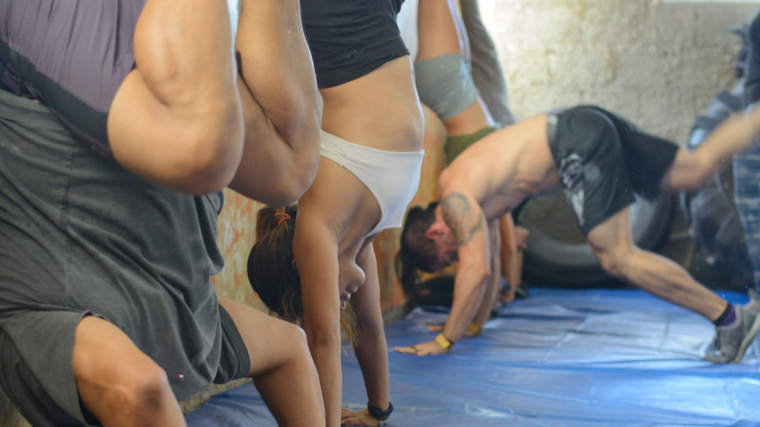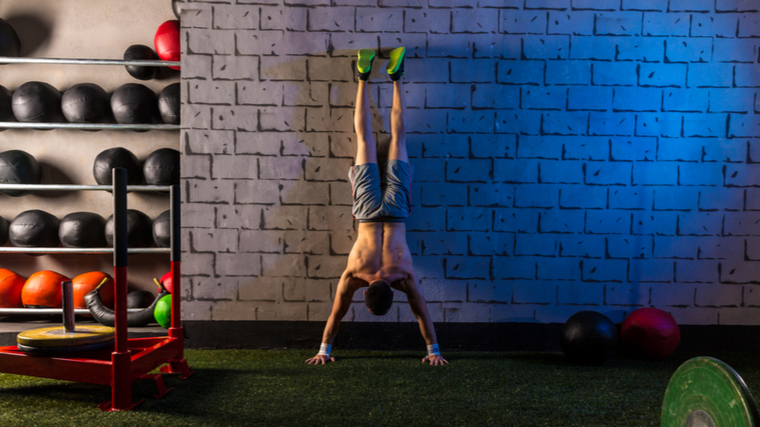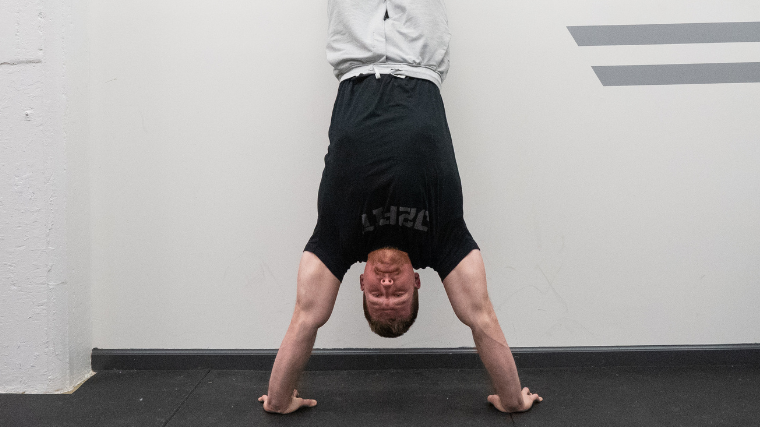The handstand push-up (HSPU) is a challenging bodyweight exercise seen in many gymnastics, functional fitness, and bodyweight training programs. While typically performed with one’s own bodyweight, thrill-seeking athletes can throw on a weighted vest or increase the range of motion for an added challenge. That being said, the HSPU is known for being plenty challenging on its own.
In this exercise guide, we lay out everything you need to know about handstand push-ups to inspire you to take advantage of this bodyweight banger.
- How to Do the Handstand Push-Up
- Benefits of the Handstand Push-Up
- Muscles Worked by the Handstand Push-Up
- Who Should Do the Handstand Push-Up
- Handstand Push-Up Sets, Reps, and Programming Recommendations
- Handstand Push-Up Variations
- Handstand Push-Up Alternatives
- Frequently Asked Questions
How to Do the Handstand Push-Up
Professional gymnasts or CrossFit devotees make inverted work look easy. However, there’s plenty to learn when working on your first HSPU. Below is a step-by-step guide on how to properly set up and perform the handstand push-up.
Step 1 — Get Set Up
Properly setting yourself up is key. Start by placing your hands about six inches from the wall, slightly wider than shoulder width. You can use a pad and place it between your hands, slightly closer to the wall if desired to cushion your head.
Coach’s Tip: The head should rest closer to the wall than the hands, to create a triangular base of support.
Step 2 — Get Inverted

With the palms and fingers pressed into the floor, kick one foot upwards towards the wall, with the back leg following. The back of your feet should lightly contact the wall, and your legs should be locked and rigid once you establish contact. Brace your core as you would during a hollow hold or plank position.
Coach’s Tip: As you invert yourself, do not fix your gaze on the floor. Instead, allow your head and line of sight to travel with your lower body such that you end up looking behind where you started.
Step 3 — Lower the Body

When starting from the top position, lower yourself downwards so that the head moves towards the pad or wall, making sure to keep the elbows inwards on a 30-45 degree angle.
Coach’s Tip: Do not allow your elbows to flare out, as it may drastically increase instability and limit your balance.
Step 5 — Press Through the Floor
From the bottom position, keep the legs pressed together and core tight, and press yourself upward. Focus on maintaining a line with your forearms to prevent elbow flare.
Coach’s Tip: If you started from the top of the moment, this is the exact way you will push yourself upwards from the bottom.
Benefits of the Handstand Push-Up
Besides looking fancy at the gym, handstand push-ups offer up some enticing performance perks. Below are four benefits of the handstand push-up that coaches and athletes from most strength, power, and fitness backgrounds can expect when implementing HSPUs into a training regimen.
Increase Upper Body Strength
The HSPU is a great movement that can be used to build strength in the shoulders and triceps, particularly during the execution of other overhead exercises. It carries many of the same benefits as more popular or conventional overhead pressing movements such as the barbell military press or dumbbell shoulder press.

The HSPU can be used by most lifters to increase general overhead strength and muscle mass without the need for external equipment.
[Read More: Train to Do 100 Push-Ups a Day]
Improved Shoulder Stability
Unlike barbells and dumbbells, the HSPU is a form of calisthenics, which means that a lifter must be able to not only move their own bodyweight in the press, but also be able to maintain proper balance and stability in the trunk and legs while doing so. Once overhead, the lifter must maintain proper stabilization from head to toe for every single repetition.
More Upper Body Muscle
Similar to the development of strength, the HSPU can be used to increase shoulder and triceps muscular hypertrophy if the training volume and demands are high enough. Bodyweight exercises do require some programming adjustments compared to traditional externally-loaded movements, but that doesn’t mean they aren’t effective for putting on muscle.
Muscles Worked by the Handstand Push-Up
The handstand push-up requires you to move multiple joints, and therefore it engages more than one muscle. Those muscles are:
Shoulders
The shoulders (deltoids) are one of the main muscle groups targeted with HSPUs. As the range of motion increases (such as in deficit HSPUs) the demands on shoulder flexion and extension increase.
Triceps
The triceps extend the elbow, making them a key player in the HSPU. Seeing that the standard HSPU is very similar to a partial range of motion strict press, the triceps are highly involved in the execution of the movement from start to finish.
Trapezius
The trapezius muscles, particularly the upper traps, provide stability and strength in the overhead position of the HSPU. These muscles primarily act isometrically to assist the shoulders and triceps in the press, providing a stable anchor for the shoulder girdle and facilitating force output.
Upper Chest
The upper chest muscle, or pectoralis minor, acts as secondary mover to the shoulders and triceps in the HSPU. The pec minor is often called into play at deeper ranges of motion, such as in reps performed from a deficit, and aid in the overall pressing movement.
Who Should Do the Handstand Push-Up
While overhead presses, bench presses, and other heavy pressing exercises are key, HSPUs can still be a great exercise to build into warm-ups, active recovery days, or even strength days. It is key, however, to master proper body positioning in the HPSU to not add unnecessary stress to the wrists, elbows, and shoulders.
Strength and Power Athletes
HSPUs are a great exercise for strength and power athletes to build into overhead warm-ups or accessory blocks as they mimic the exact position weightlifters are in when performing jerks or push presses. HSPUs can be used also to increase training volume without having to use excessive amounts of loading on the spine.
Functional Fitness Athletes
Aside from the fact that HSPUs are a necessary skill and movement that CrossFit athletes perform on a regular basis in classes and competitions, they also can help to increase overhead strength and muscle mass that has relevance in most aspects of their training regimes.
Regular Gymgoers
The HSPU is a more advanced bodyweight movement that can be progressed towards with proper technique, skill development, and strength acquisition. The ability to perform a proper strict HSPU also can be used as a general marker for upper body strength capacity, body and core awareness, and advancement into more challenging overhead movements. This makes it a suitable target for the average gym rat looking to kick their training up a notch.
Handstand Push-Up Sets, Reps, and Programming Recommendations
If you believe the handstand push-up is for you, here are some programming notes you can use to build them into your workouts. Below are three sets, reps, and intensity recommendations for coaches and athletes to properly program the handstand push-up based on training goal.

[Read More: Best Upper Chest Exercises for Building Muscle]
Note that the below guidelines are here to offer coaches and athletes loose recommendations for programming, and are not the only way to program them.
To Improve Technique
When learning how to handstand push-up or improve technique, you can perform them using blocks and padded floors. Blocks will help to limit the range of motion, and padded floors can protect you against injury if you fall or lose your balance.
Start by performing three to four sets of up to five repetitions, resting two to three full minutes between sets to allow for complete recovery.
To Build Strength
For strength building, perform lower repetition ranges for more total sets. If you need more resistance to drive progress over time, increasing the range of motion or throwing on a weight vest can be a suitable method for overloading the movement.
Start by performing three to five sets of three to five repetitions, resting up to three minutes between sets to allow for full recovery. Press from a deficit or use a weight vest to increase the difficulty of your work.
To Gain Muscle and Size
Using bodyweight training for hypertrophy can be tricky, but it is possible. The key element is to accumulate lots of training volume, emphasize your eccentrics, and train hard without hitting a level of fatigue that interferes with your performance on subsequent sets.
Start by performing two to three sets, stopping up to three reps short of perceived failure. Over time, push for shorter rest between sets, slower eccentrics, and more total sets performed per session.
Handstand Push-Up Variations
Adding diversity to your handstand push-up training can help you strengthen positions, address technique breakdowns, or modify workouts as needed. Below are three HSPU variations that can be used by coaches and athletes to keep training varied and progressive.
Deficit Handstand Push-Up
The deficit HSPU can be done using parallettes, stacked plates, or any other means that allow you to have your hands closer to your shoulders at the beginning. In doing so, you increase the range of motion and pressing strength needed in that deeper range of motion, making the handstand push-up more challenging.
Tempo Handstand Push-Up
The tempo handstand push-up can be done to increase time under tension and enhance strength tendencies throughout specific ranges of motion. By using a tempo during the HSPU, more strength and control is needed throughout the eccentric phase of the movement. A slower eccentric will lead to more confidence in performance and hopefully some extra strength as a bonus.
Kipping Handstand Push-Up
The kipping movement is often seen in gymnastics and functional fitness movements where an athlete is either (1) trying to move more efficiently by using momentum, or (2) to help them perform a movement using momentum that they would otherwise not be able to do with pure concentric strength.
The kipping HSPU, like most kipping movements (such as the kipping ring dip) works the same muscle groups and allows for the opportunity to increase training volume (ability to do more sets and reps due to the usage of momentum) which can increase muscle hypertrophy and endurance.
Handstand Push-Up Alternatives
The handstand push-up can be very difficult to perform, both from a technical aspect and considering the immense upper body strength required to bang out multiple repetitions. Try out these handstand push-up alternatives for similar strength and muscle building benefits if HSPUs are out of reach.
Wall Walks
The wall walk is a great movement to build into warm-up segments or to help beginner lifters increase overhead strength and stability in a less demanding manner while still providing a great core and upper body workout.
By moving from a push-up position gradually into a handstand, you can dynamically challenge the core, establish isometric overhead strength, boost bodily control, and help develop the proprietary awareness to move on to handstand push-ups over time.
Incline Push-Up
The incline push-up can be done at varying heights with the ability to shift tension emphasis on the upper body. As the height of the bench or box becomes higher, you can even bend the knees and become inverted with the hips much higher than the shoulders to really increase upper body strength and pressing capacities.
Z Press
The Z Press is a pressing movement that can be done with a barbell, dumbbells, kettlebells, or any other form of load that can be done to increase overhead pressing strength, build proper overhead pressing awareness, and increase core stability necessary for the HSPU.
Many individuals who struggle with performing HSPU can benefit from performing the Z Press to build stronger shoulders, upper back muscles, and double down on core strength.
Final Word
The handstand push-up is a classic upper body mass and strength builder for bodyweight training enthusiasts, home gym warriors, and gymnasts as well. While the handstand push-up can be very challenging for many lifers, it can be regressed and modified for most individuals to suit their needs.
If you are looking for an upper body exercise that build serious pressing strength, increase muscle mass, and boost body awareness all at once, look no further than the handstand push-up.
Frequently Asked Questions
Should you face the wall or face away from the wall when doing handstand push-ups?
Facing the wall during handstand push-ups will increase the need for hand balancing and upper body strength, as you cannot lean backwards and use the wall as a support.
If you are a beginner, facing away from the wall may be easier, however be careful not to overly depend on the wall for balance and strength.
Is kipping during the handstand push-up bad for your neck?
Uncontrolled movements where you are landing on your spine and head are likely not the best for your neck, and this is one reason why some individuals may get injured during fast-paced, ballistic style kipping handstand push-ups.
If you are kipping, be sure to not use your head and neck/spine as a means to “bounce” off the floor to aid in getting back up.
Featured Image: Zoriana Zaitseva / Shutterstock
